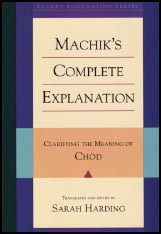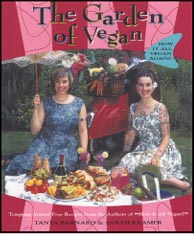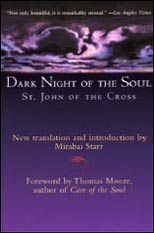The Uddhava Gita: The Final Teaching of Krishna
trans. Swami Ambikananda Saraswati
Ulysses Press 2002
 I love this translation of the Uddhava Gita. Swami Ambikananda's
intuitive, graceful language has brought to life this ancient,
powerful scripture in a way that is engaging and relevant for
us today. Perhaps it is not surprising that the translator was
able to do this, as she is an initiate into the Saraswati order.
Saraswati the goddess of poetry, arts and the spoken word is considered
in Indian mythology to be the embodiment of perfection and intimate
knowledge. It is said that to be deeply touched by the words of
another is to have direct experience of Saraswati herself. Swami
Ambikananda's translation has the power to touch the heart directly.
I love this translation of the Uddhava Gita. Swami Ambikananda's
intuitive, graceful language has brought to life this ancient,
powerful scripture in a way that is engaging and relevant for
us today. Perhaps it is not surprising that the translator was
able to do this, as she is an initiate into the Saraswati order.
Saraswati the goddess of poetry, arts and the spoken word is considered
in Indian mythology to be the embodiment of perfection and intimate
knowledge. It is said that to be deeply touched by the words of
another is to have direct experience of Saraswati herself. Swami
Ambikananda's translation has the power to touch the heart directly.
The scripture is part of the larger Bhagavatha Purana, a text that depicts the life and teachings of Lord Krishna. Its twelve volumes were composed in India during the ascendancy of Bhakti Yoga, sometime between 3000 and 1400 BCE.
Uddhava is an older man, a close devotee and counselor to Krishna, and this gita or "song" is
a dialogue between them. On the eve of Krishna's departure from Earth, he instructs his elder devotee in the art of preparing for death the ultimate renunciation. Gently, and with great consideration and respect for his friend, Krishna describes the illusory, impermanent nature of life, and teaches Uddhava the way to Liberation.
The dialogue is made very transparent by the intimacy and trust between them and I felt at
times like a participant observing, listening and being called to think deeply about my life and what really matters. This
translation is so accessible that one does not need to know anything about Hindu religious mythology to have a similar experience.
Both the Uddhava Gita and the better known Bhagavad Gita come from an oral tradition
that goes back to the Vedas, which are
considered to be the source of all knowledge. Like the sacred rivers from which they are said to have arisen, these songs have
nourished and given life to the people for thousands of years. Their teachings are important for us to hear if we are to know
more deeply the spiritual roots of our daily practice in yoga. Works like Swami Ambikananda's Uddhava Gita make such "hearing"
possible.
Swami Gopalananda
back to top
Machik's Complete Explanation: Clarifying the Meaning of Chod
trans. and ed. Sarah Harding
Snow Lion 2003
 Machik was a Tibetan saint and yogini of the eleventh to twelfth
century whose method of overcoming ego fixation, called Chod,
was very radical. Chod is translated as "cutting" or "severance."
The tradition is renowned for its graphic visualizations, such
as cutting up one's body to offer to demons in charnel grounds.
This method definitely grabs the imagination. But more importantly,
Chod is training in awareness "through the willingness to accept
what is undesirable, the disregard of difficult circumstances,
the realization that gods and demons are one's own mind, and the
understanding that oneself and others are utterly equal."
Machik was a Tibetan saint and yogini of the eleventh to twelfth
century whose method of overcoming ego fixation, called Chod,
was very radical. Chod is translated as "cutting" or "severance."
The tradition is renowned for its graphic visualizations, such
as cutting up one's body to offer to demons in charnel grounds.
This method definitely grabs the imagination. But more importantly,
Chod is training in awareness "through the willingness to accept
what is undesirable, the disregard of difficult circumstances,
the realization that gods and demons are one's own mind, and the
understanding that oneself and others are utterly equal."
Machik's Complete Explanation is a fascinating look into an ancient tradition and its graphic method of renouncing fears, concepts and cherished beliefs. Understanding the meaning of the gods and demons is essential to understanding Chod. Translator Sarah Harding explains it simply: "If you don't think you believe in gods and demons, consider whether you don't believe anything is good or bad, right or wrong." Chod aims for the deepest, most hidden level of attachments to our bodies, concepts, fears, and unresolved grudges and resentments. Once we have overcome these inner demons through the practice of offering, feeding and nurturing them, they become helpless and even helpful to us.
As well as going deep into the mind to face our demons, the practices encompass immeasurable love, compassion, joy and equanimity. "There is not a single being who has not been your mother, father, friend and relative," Machik says. "Therefore you cannot say 'demon.'"
Machik's Complete Explanation is the first complete English translation of this text. The book also contains biographical information about Lapdron, as she was called as an aspirant, and the leap that she made to become a legendary figure and a great spiritual teacher. The story is told that Lapdron was doing a recitation practice of the Prajnaparamita Sutra. At one point while she recited the chapter concerning devils, she suddenly understood; and "Lapdron the woman and Machik the dakini of timeless wisdom merge."
Many of the teachings are written in the traditional form of a dialogue, as her disciples ask questions about the Chod practices. Reading the dialogues is like being right there with Machik as she teaches. She explains the sequence of practices and what to expect if you do them correctly. Machik also gives much detail about death and dying, the system of energy channels in the body, physiology, and even what people should wear.
How does Machik's method differ from any other Buddhist practice?
Sarah Harding's teacher Thrangu Rinpoche says Chod is the same as other forms of Buddhism only more so. "We say something is 'only in your mind' as if it is a small matter. Yet what could be more powerful? And where else could something be?" This text conveys an understanding that there are no inner and outer worlds, but one continuous, seamless whole.
It is important to find ways to clear the mind. It is important to ask, what am I willing to give up
to attain clarity? What am I willing to give up in order to be free?
Swami Radhananda
back to top
The Garden of Vegan
Arsenal Pulp Press 2003
Tanya Barnard and Sarah Kramer
 For many of us, when we think of a vegan diet, we think of what
must be given up: meat, dairy and eggs. But why not focus on what
we can gain by shifting our food choices to avoid animal products?
Whether it's for one meal or our whole life, eating vegan can
contribute to our overall physical well-being and it's also much
less taxing on the planet's resources. The Garden of Vegan
is an excellent guide to making balanced vegan meals that will
not limit your culinary horizons - chances are, it will expand
them.
For many of us, when we think of a vegan diet, we think of what
must be given up: meat, dairy and eggs. But why not focus on what
we can gain by shifting our food choices to avoid animal products?
Whether it's for one meal or our whole life, eating vegan can
contribute to our overall physical well-being and it's also much
less taxing on the planet's resources. The Garden of Vegan
is an excellent guide to making balanced vegan meals that will
not limit your culinary horizons - chances are, it will expand
them.
With their first book, How It All Vegan, best friends Sarah Kramer and Tanya Barnard showed us
that vegan cooking is not only easy and tasty, it can also be a really good time. In Garden, they take their culinary craft to the
next level, with recipes that are a bit more sophisticated. The celebratory attitude toward the act of cooking in this book even
surpasses the distinct charm of their first.
The Garden of Vegan is full of recipes, kitchen and lifestyle tips that are grounded in a true
appreciation of food as nourishment for the body and mind. Cooking with this cookbook is like having a guest in your kitchen offering
advice and stories to round out the act of preparing your meal. From recipes that are vegan updates of old family favourites
like "Nana Marg's Bran Muffins" or "Aunty Bonnie's Black Bean Soup," to contributions from fans and friends like "Claire's Red and Racy
Salad," "Matthew's Delicious Tofu" or my favourite, "Kurstin's Walnut Burgers," the stories that are woven throughout the book bring a
human touch to each recipe.
Also included are instructions for making your own animal-friendly household and beauty products;
a very handy guide to egg substitutes; and an extensive appendix of animal-derived products for the conscious consumer to avoid.
The true test of any cookbook, for me, is how often I use it. As a busy person who values good
food, but can often find it hard to squeeze into a hectic schedule, I have found myself coming back to this cookbook again and again
for quick, inspiring, delicious meals.
Emira Mearsback to top
Dark Night of the Soul
trans. Mirabai Starr
St. John of the Cross
 Three hundred years ago, St. John of the Cross wrote a beautiful
work of Christian mystical poetry, describing his own spiritual
journey toward union with the Divine in love. He then added commentary
that maps out the path with careful precision. In Dark Night
of the Soul, St. John describes a path of "horrendous" suffering,
renouncing all desires and losing all sense of a personal Self.
Three hundred years ago, St. John of the Cross wrote a beautiful
work of Christian mystical poetry, describing his own spiritual
journey toward union with the Divine in love. He then added commentary
that maps out the path with careful precision. In Dark Night
of the Soul, St. John describes a path of "horrendous" suffering,
renouncing all desires and losing all sense of a personal Self.
Mirabai Starr's new English translation of the Spanish saint's text is a strong and deeply personal challenge to accept suffering as a meaningful part of our spiritual experience. I don't think many people will ever experience the Divine ecstasy that St. John's suffering led him to. But we all experience pain, and so we must learn how to either relate to our suffering or be trapped by it. This book is a reminder that taking a spiritual path in life is the ultimate challenge.
Starr's words are straightforward, and she draws effectively on Asian spiritual traditions to bring clarity to the text for readers who may not practise Christianity. The most outstanding example of this is her interpretation of St. John's "Devil" as "the Fragmented Self." Some of Starr's adaptations blur the finer points of St. John's religious beliefs. My own feeling is that religion blending can confuse the subtleties of belief systems and ignore the value of diversity. However, St. John himself is not too concerned with doctrine. He speaks on a level of personal experience that is likely to resonate with anyone who does a spiritual practice. St. John's original intention was to offer guidance to all those who are suffering through spiritual hardship, and Starr's translation is fitting to this intention.
While Starr succeeds in making the text accessible, she also keeps it challenging.
It is difficult to describe my own experience of this work, but I had shocking revelations of the extent and the strength
of my own attachments, and a glimpse into what is required to truly let go. Although reading Dark Night of the Soul was at times difficult, it left me with a deep feeling of relief, freedom and acceptance. St. John's text is so rewarding because it says things we may not want to hear.
Mirabai Starr's translation does not shy away from this challenge.
Ian Cantback to top
Portals of Grace
Azam Ali
Narada 2002
| click here to listen |  |
Each time I hear Azam Ali's ethereal vocals, I am enraptured by her musical spell. Whether she is singing a chant from the German
abbess Hildegard von Bingen, or improvising imaginary words, Ali's voice is both sacred and sensual. On Portals of Grace, she creates a mood of serenity and introspection.
Ali was born in Iran but raised in India for eleven years and is now based in the United States.
She is part of the world music duo Vas, along with percussionist Greg Ellis. While Vas has focused on original compositions,
Portals of Grace, Ali's first solo recording, is comprised of traditional music. The CD transports us back in time to the twelfth to fourteenth centuries with music from French, Latin, Judeo-Spanish and Arabic cultures. Ali sings in a variety of languages, with themes as diverse as secret love affairs and heroic troubadours, to sacred chants and spiritual songs. The common thread, however, is the intense devotion in her singing.
A variety of period instruments supports Ali's vocals. The rebec, hurdy-gurdy, oud and vielle play against cello, keyboards and percussion. The instrumentation on this CD is sparse and has a very organic sound. I find it refreshing to feel a sense of space within the music.
Azam Ali makes no claims to adhering to tradition. In fact, she says her intent was to give this medieval music a contemporary feel. While sidestepping tradition may rub purists the wrong way, she states that artistic creation is a direct response to an innate call within each artist. She says, "I see the human voice as a reflection of our truest self that is within us, through which we can mirror forth, either through prayer or song, the beauty and the Grace of God." Her music strikes a perfect balance between artistic creativity and honouring the heritage and reverence of the music.
Portals of Grace is a special recording. Save it for those moments when you want to invoke magic in your sacred space. Let the music fill the air without distraction.
Also worthy of mention, a portion of the proceeds from the sale of this CD is being
donated to RAWA, the Revolutionary Association of Women in Afghanistan.
John Arif Verner
back to top